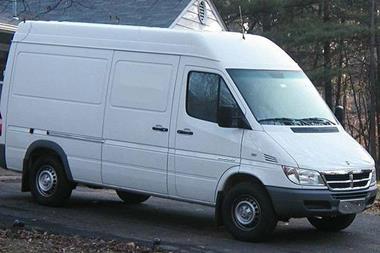Prospects in the sector are poor, or at least that’s the pessimist’s view. But rates are starting to creep up. Slow progress in forcing through rises is due to the squeezed market and greater competition – but increases may come as companies feel the pain
There’s good news and bad news for insurers and brokers selling fleet insurance. The good news is rates are rising and – say it quietly – some optimistic souls even believe that prices are showing tentative signs of hardening.
The bad news is that the pace of increase is more akin to a snail on Valium than a racehorse on steroids.
Although motor rates are on the up, a combination of a sharp rise in claims inflation and new entrants to the sector means that insurers still have some way to go before the motor fleet regains profitability.
While everyone agrees that rates in fleet insurance need to rise significantly, industry opinion is divided over whether the current upward trend, meagre as it is, is sustainable against the background of the uncertain economic climate. This is despite a determination on the part of some in the industry to make price rises stick. “The problem is that fleet is a very tough market,” Datamonitor general insurance and financial services analyst, Sylvia Li, says. “I don’t see evidence of rates hardening, although they are increasing. The sector needs to raise rates significantly but at the moment it is unable to do that.”
So what is the problem? Well, in common with everything else, fleet has been badly hit by the global financial crisis.
“Basically clients are finding themselves unable to pay higher premiums and at the same time the recession has shrunk the size of the market,” head of commercial motor with AXA, Simon Baker, says. “About 18 months ago, fleet rates started to rise, but when the recession hit, it knocked all the wind out of it.”
It is worth pointing out that last year’s Department for Transport vehicle licensing statistics showed that the number of company-owned cars fell by almost 4.5%, while new registrations plunged 21%. The continuing effect of the economic crisis, not to mention last month’s emergency Budget – which will increase VAT from next January – is likely to ensure that the decline in the size of commercial fleets continues, leading to both smaller pools of vehicles and fewer clients.
Groupama head of commercial underwriting, Dawn Dillaway , agrees that the fledgling increase in rates has slowed sharply during the first half of this year but points to increased capacity, as well as the economic downturn, as a large part of the problem.
“The main reason is new players coming into the market who are buying business. That’s making established players, who are trying to carry rises, think twice. They need to hold on to business.”
Dillaway’s view of the cause of the market ills is partly supported by Fortis underwriting development manager, Ron Munro. Fortis is one of the new entrants into the fleet market, although Munro insists increased capacity is not merely about buying market share.
He says: “Yes, there are a significant number of players in the market, and there are new players coming into it and, yes, that does keep pressure on rates.
“But we approach our business with an emphasis on longevity of connection between ourselves and the client, and that helps to avoid sharp increases in premiums.”
Claims inflation is also identified as a prime culprit when it comes to attempts by fleet insurers to make their books turn a profit.
While prices have crept up, claims inflation has soared, consistently outstripping rate rises over the last five years.
“Long-term claims inflation is a big issue,” Baker says. “There has been an increase in third-party claims in recent years. In the 1980s, there was a crime-related impact, but today it is third-party.”
Datamonitor estimates that claims inflation is running at about 6% across fleet and commercial, although some insurers insist it is in double digits, while rate increases are measured in low single figures.
“Bodily injury claims are continuing to rise,” Allianz commercial motor manager Jon Dye says. “Credit hire is another factor. It accounts for about 10% of premium payments now, whereas it used to be no more than 2%. It’s a huge problem that needs to be tackled if we are going to sort out rates in fleet.”
There are also other less obvious pressures on sector prices that the industry is nervously anticipating, such as the recently implemented Ministry of Justice reforms.
Although most insurers are optimistic that the additional pressure to complete the claim process more quickly will be offset by savings, there are fears that the reforms will also lead to more claims.
Add in the usual suspects of continuing falls in investment returns and low interest rates – which have left insurers unable to rely on bumper reserve releases from previous years to bolster their bottom line – and you could argue the entire sector is starting to resemble a slow-motion car crash.
Yet, amid the gloom, there is a dogged determination among underwriters to get some sustainable upward momentum into prices.
Rather than clinging to the philosophy of New Labour’s old anthem Things Can Only Get Better, some insurers are pushing George Osborne’s High School Musical mantra of We’re All In This Together and attempting to instil discipline into pricing.
“I think prices are hardening a bit more because there have been moves within the market to push rates up,” Dye says. “There is more discipline on the part of insurers now and the key drivers behind that, along with claims inflation, is the reduction of prior years’ releases.”
Dye believes the sector’s current pricing regime is unsustainable. The most recent FSA returns show the commercial market had combined operating ratio rates of 110% in 2009, including more than 7% of reserve releases.
“That can’t continue,” Dye insists. “We have to get a return to discipline and underwriting profit because we can’t sustain losses and it’s a loss-making market.”
But the problem appears to be that not everyone believes they are in it together.
Dillaway says: “Traditional players are trying to push rates but not all underwriters are supporting that. Too many insurers tarred everyone with the same brush in terms of rises, and for many clients the increases have come in one go. For a lot of them, that’s all been hard to swallow.”
Dye believes the next six months could prove to be crucial for the sector as more insurers “feel the pain” of current rate levels against spiralling claims and fewer clients. “Rates need to rise,” he says.
But Datamonitor’s Li adds a note of caution.
“If we take look at private motor, we know rate hardening doesn’t happen quickly. It is a competitive environment in fleet. I believe that in the current market insurers will still price competitively to maintain their book.” IT
ebay for fleet insurers?
Private motor insurance has been transformed by the online revolution with about 70% of all business now being carried out via the internet. But despite some inroads in the sector, the broker remains king when it comes to fleet insurance.
“Most fleet business is placed through brokers, probably as much as 90%,” Fortis underwriting development manager, Ron Munro, says. “This stems from the fact that clients require more than just fleet insurance and trust a broker to place all their business for them.”
That view is echoed by Allianz commercial motor manager, Jon Dye. “Fleet clients need reliable advice on managing risk, particularly nowadays on things like health and safety regulations and issues surrounding corporate manslaughter legislation. All that makes selling fleet insurance very different from commodity-type web-based insurance,” he says.
But despite the dominant role of brokers in the sector, online trading is starting to get a foothold, most notably through Blagrove’s increasing popular Direct Fleet website, originally launched under the aegis of Kerry London.
Direct Fleet is supported by most of the large fleet insurers including Aviva, AXA, Carraig, Fortis, Groupama, LV=, Markerstudy, NIG and Zurich.
The site is basically a reverse version of eBay for fleet insurers. The fleet owner or more usually the insurance broker goes to the site and submits details of the fleet requiring cover. Insurers can view the details and then bid against each other to win the contract, with the lowest bid scooping the pot.
Just like eBay, both buyers and sellers can see what has been offered at any time before the end of the auction and insurers can lower their original bids to win the business right up the transaction deadline.
“The deadline to make a quote offer varies depending on the [policy] renewal date. It can be as little as 24 to 48 hours, or as much as three weeks,” Munro says. “You can see what the lowest bid is, although you can’t see who has placed it. It’s up to you if you want to reduce your offer and beat the lowest bid to get the work.”
The vision of the industry’s top underwriters crouched over their office computers eagerly watching bid changes in the way the rest of us do when bidding for a Nintendo Wii on eBay is amusing, though not entirely accurate.
“We don’t sit about staring at the computer screen looking at the bidding,” Munro insists. “But if it’s business that we want, we will check it before the deadline closes and make a decision about making a further bid then.”
But in a sector plagued by historically low rates, doesn’t this distribution method merely encourage insurers to cut each other’s throats for a policy?
“There’s an element of that,” AXA head of commercial motor Simon Baker says. “But if you treat it like eBay, you may have issues with margins, because then you are getting into the aggregator model where everyone is focused on price. Fleet isn’t like that – clients need to understand what they’re buying.”
The total fleet insurance market is worth about £2bn and it is estimated that more than £6m of that is placed on Direct Fleet.
“The Direct Fleet model does work pretty well but it probably hasn’t taken off in the way it should,” Groupama, head of commercial underwriting Dawn Dillaway says. “I think more fleet will eventually go online. The software houses are developing systems for fleet and it’s the way the industry overall is moving, but it will really only be able to accommodate smaller fleets.”






































No comments yet